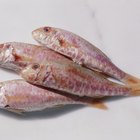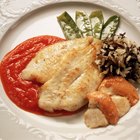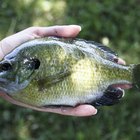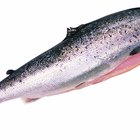
For anglers of all ages, catching a meal of panfish is one of the pleasantest ways to spend an afternoon. These are fish such as crappies, bluegills and perch, which abound in the country's lakes and streams. They're all tasty and just the right size for a frying pan, a happy combination for any fish lover. Fresh perch can be eaten whole or in fillets, depending on the cook's preference. Usually they're pan-fried, but they can be baked for a lower-fat alternative.
Preparing the Perch
Step 1
Scale the perch if you want to cook them whole or if you like fillets with the skin left on and fried crisp. Gut the fish with a sharp knife and rinse out their belly cavities. If you plan to cook the fish whole, use your knife or a pair of kitchen shears to cut away the spiny fins from their backs.
Step 2
Fillet the perch, if you wish, by cutting along the backbone from the head to the tail. Turn the perch over and remove the second fillet the same way.
Step 3
Remove the rib bones by sliding your knife underneath them, angling the blade toward the bones to minimize waste. Make one long, smooth stroke to take off the rib bones and the thin membrane holding them together. Repeat for the remaining fillets.
Step 4
Skin the fillets, if you wish, by making a shallow diagonal cut at the tail until your knife blade reaches the skin. Hold the narrow tail in place with one hand, then draw your knife along the skin until it reaches the end and frees the fillet from the skin. The boneless fillets are now ready to cook.
Pan-Frying Your Perch
Step 1
Heat a heavy skillet over medium-high heat. Season your fillets or small whole perch with salt and pepper, then dredge them lightly in flour or fine cornmeal. Shake off any excess.
Step 2
Pour a half-tablespoon of your favorite cooking oil into the skillet and fill the pan loosely with perch or perch fillets. Don't overcrowd the pan. There should be plenty of space between the portions, so steam can escape from the cooking fish and let them become crisp. Fillets should always be started with the skin-side facing up.
Step 3
Cook fillets for 2 to 3 minutes on the first side, until they're lightly golden and beginning to turn from translucent to white. Whole small perch will take longer, approximately 3 to 5 minutes.
Step 4
Turn the perch or fillets, and cook for approximately the same length of time on the second side. The thickest part of the fillet should just be turning white if you pull the fillet apart with the tip of your knife. Whole perch are finished when the flesh lifts away from the backbone.
Step 5
Remove the perch from your skillet and serve them immediately, or keep them warm in your oven while you fry any additional portions.
Baked Perch
Step 1
Brush or spray perch fillets lightly with vegetable oil, then season them with salt and pepper. Whole perch should be seasoned inside the belly cavity, as well as on the outside.
Step 2
Arrange the perch evenly on a parchment-lined baking sheet, leaving plenty of space between the portions. Preheat your oven to 425 degrees Fahrenheit for fillets, or 400 F for whole perch.
Step 3
Bake your fillets for 9 to 12 minutes, or until they're no longer translucent in the middle of the thickest part of the fillet. Whole perch take 15 minutes or longer, depending on their size, and should be turned halfway through their cooking time. They're done when the flesh lifts away easily from the backbone.
Step 4
Serve hot from the oven with your favorite side dishes.
Related Articles

How to Cook Fresh Brook Trout

How to Clean Mullet

Easy Way to Debone a Trout
How to Cook Bone-in Tilapia

How to Cook Sauteed Perch Fillets

How to Clean Tilapia

Can You Eat the Skin on Grilled Trout?

How to Cook Bluegill on the Grill

How to Cook Jackfish

How to Cook Trigger Fish

How to Cook Salmon Cheeks

How to Cook Saba Fish

How to Cook Whole Butterfish
The Best Way to Cook Tilefish
How to Cook Seasoned Keta Salmon

How to Cook Flathead

How to Cook a Sunfish

The Best Way to Cook Hake

How to Cook Pickerel in the Oven
How to Cook Atlantic Cod Fillets
References
Tips
- Perch fillets can also be breaded before frying or baking. This helps keep them moist and adds a pleasant flavor and texture. Cook the perch slightly longer, because the breading acts as an insulator.
- To grill perch instead of pan-frying them, clean and oil the grate thoroughly before you heat it. Oil the perch fillets lightly, to help prevent sticking. Use a fish-grilling basket to minimize the likelihood of the fillets breaking up when you turn them.
Writer Bio
Fred Decker is a trained chef and prolific freelance writer. In previous careers, he sold insurance and mutual funds, and was a longtime retailer. He was educated at Memorial University of Newfoundland and the Northern Alberta Institute of Technology. His articles have appeared on numerous home and garden sites including GoneOutdoors, TheNest and eHow.
Photo Credits
Jupiterimages/Photos.com/Getty Images